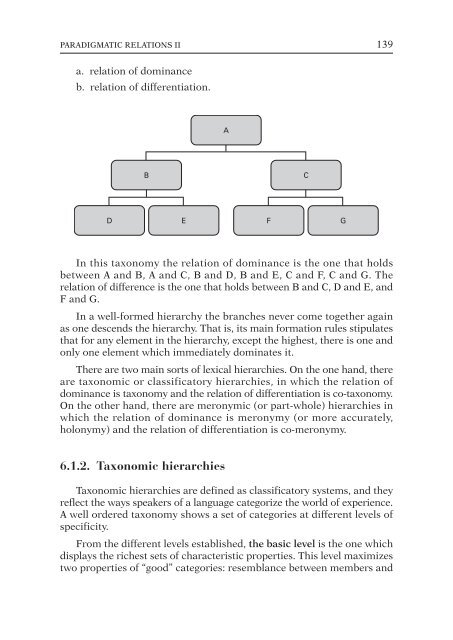Semantics
You also want an ePaper? Increase the reach of your titles
YUMPU automatically turns print PDFs into web optimized ePapers that Google loves.
PARADIGMATIC RELATIONS II 139<br />
a. relation of dominance<br />
b. relation of differentiation.<br />
A<br />
B<br />
C<br />
D E F G<br />
In this taxonomy the relation of dominance is the one that holds<br />
between A and B, A and C, B and D, B and E, C and F, C and G. The<br />
relation of difference is the one that holds between B and C, D and E, and<br />
F and G.<br />
In a well-formed hierarchy the branches never come together again<br />
as one descends the hierarchy. That is, its main formation rules stipulates<br />
that for any element in the hierarchy, except the highest, there is one and<br />
only one element which immediately dominates it.<br />
There are two main sorts of lexical hierarchies. On the one hand, there<br />
are taxonomic or classificatory hierarchies, in which the relation of<br />
dominance is taxonomy and the relation of differentiation is co-taxonomy.<br />
On the other hand, there are meronymic (or part-whole) hierarchies in<br />
which the relation of dominance is meronymy (or more accurately,<br />
holonymy) and the relation of differentiation is co-meronymy.<br />
6.1.2. Taxonomic hierarchies<br />
Taxonomic hierarchies are defined as classificatory systems, and they<br />
reflect the ways speakers of a language categorize the world of experience.<br />
A well ordered taxonomy shows a set of categories at different levels of<br />
specificity.<br />
From the different levels established, the basic level is the one which<br />
displays the richest sets of characteristic properties. This level maximizes<br />
two properties of “good” categories: resemblance between members and



